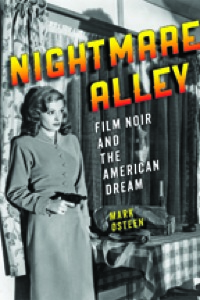Click here to print
Surprises Down Nightmare Alley
posted May 27, 2013
 Sure, the film noir features wise-cracking detectives and alluring femmes fatales. It even extols these characteristics as enviable personality traits. But is that the real point of the genre?
Sure, the film noir features wise-cracking detectives and alluring femmes fatales. It even extols these characteristics as enviable personality traits. But is that the real point of the genre?
In Nightmare Alley: Film Noir and the American Dream (Johns Hopkins University Press), by Mark Osteen, a professor of English and founder of the film-studies program at Loyola University Maryland argues that the film noir really is much more. He shows that, in the wake of World War II, the noir genre tested and ultimately discounted notions of upward mobility, individualism, liberty, equality, and free enterprise.
To make his case, Osteen employs perspectives from such fields as psychoanalysis, art history, feminism, and music theory. He examines such figures as desperate young lovers on the lam (They Live by Night), a cynical con man making a fortune as a mentalist (Nightmare Alley), a penniless pregnant girl mistaken for a wealthy heiress (No Man of Her Own), and a wounded veteran who has forgotten his own name (Somewhere in the Night). What such noir characters have in common, Osteen shows, is that they are working hard, and persevering, to overcome social origins and achieve material success. But the battle is some very steep hills.
Mark Osteen describes some of the challenges and surprises of his research:
There were a few archival challenges and surprises for me in researching and writing Nightmare Alley.
A few of the films are hard to find. Aside from the “canonical” noirs – Out of the Past, The Killers, Detour, et al – some of them are quite obscure: neither well known at the time nor today. Many are not available on home DVD. I had to use a Region 2, Spanish-language version of Robert Siodmak’s The Strange Affair of Uncle Harry. For some films, such as The Accused, No Man of Her Own, The Chase, The Underworld Story, and Try and Get Me!, among others, I relied upon old VHS tapes that I had recorded from late night movies, often years ago. Most of the prints were in rough shape, and the fuzzy videotape images didn’t help. Still, I’m really glad that I was on that taping binge all those years ago.
As to archives, the Margaret Herrick Library in Los Angeles was an indispensable source. I was able to locate script drafts for several films written by women, along with unexpectedly interesting ancillary materials. For example, I learned from looking at Hal Wallis’s contracts that one woman writer, Ketti Frings, was paid more for her script work than any of the male writers who’d taken a shot at it! The PCA files are also filled with fascinating material. For instance, I found a telegram from Ida Lupino to Joseph Breen, in which she defends herself herself after a newspaper reporter in Wisconsin had turned an interview with Lupino into an excuse for condemning her film Not Wanted (about an unwed mother). Because Lupino had worked with the PCA to develop the script, Breen actually wrote to the newspaper defending this provocative film. Now that was unexpected!
I also found, in Paul Henreid’s papers housed there, an annotated script of a film in which he starred (and that he also produced), Hollow Triumph. Inside the bound script was a long essay to Henreid and director Steve Sekely from screenwriter Daniel Fuchs, filled with character details and instructions. As far as I know, nobody else had ever seen this material. Those were the sort of things that made the whole trip worthwhile.
Printed from Moving Image Archive News: http://www.movingimagearchivenews.org
URL to article: http://www.movingimagearchivenews.org/surprises-down-nightmare-alley/
Click here to print